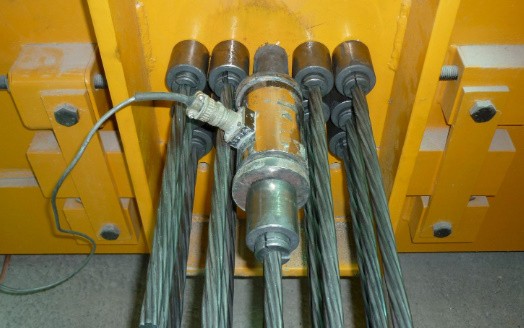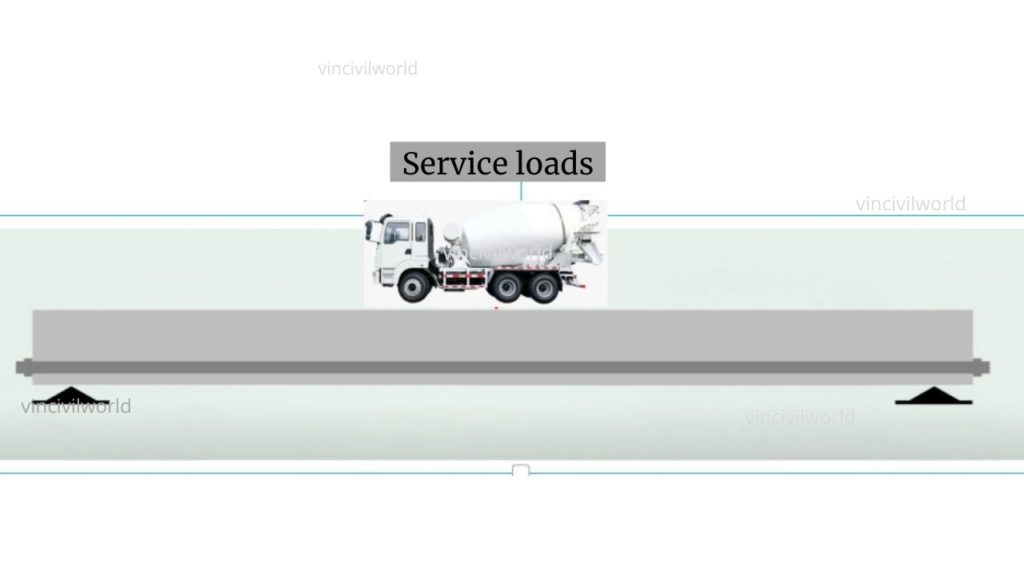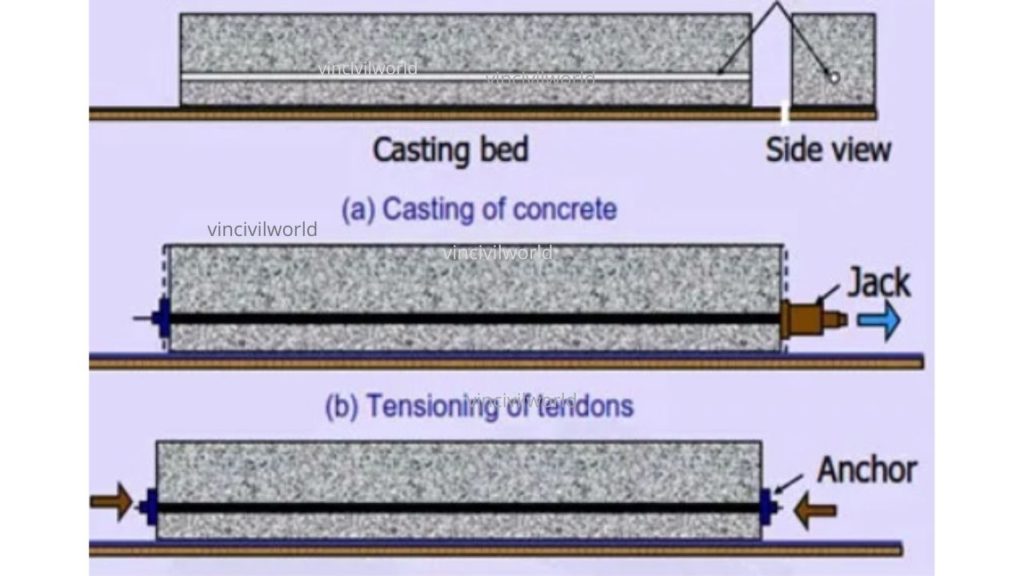The prestressing in Prestressed concrete is done by inducing predetermined compressive stresses to concrete by tensioning the steel, before subjecting it to service loads. In prestressed Concrete the stress developed during the service stage is countered by the already induced compressive stresses. Prestressing is a combination of the high-strength compressive properties of concrete with the high tensile strength of steel. This article is about prestressing in prestressed concrete, different methods of prestressing, and how prestressing works.
Prestressing in Prestressed concrete
Concrete got excellent properties, making them the most preferred material for structural members, but has its weakness too. Let us consider two cases where a concrete beam is subjected to loads.
- CASE 1 ( PLAIN CEMENT CONCRETE BEAM ON LOADS)
- CASE 2 (REINFORCEMENT CEMENT CONCRETE ON LOADS)
Plain Cement Concrete Beam on Loads
Let us consider a Plain Cement Concrete (PCC) beam subjected to loads as shown in Fig. The beam bends and cracks are developed in the tensile zone. This confirms that the concrete is very weak in tension and strong in compression.
Reinforced Cement Concrete beam on loads
Consider a reinforced Cement Concrete beam subjected to loads as shown in fig. In this case, the beam will not bend or cracks. This is due to the presence of reinforcement steel in the tensile zone. The reinforcement steel takes care of the tensile loads and prevents the member from cracking.
In this case, the RCC beam with steel behaves as a composite member. Concrete’s poor tensile strength and ductility are countered by the reinforcement steel having high tensile strength and ductility.
Significance of Prestressed Concrete
Even though concrete owes the property of good compressive strength, it has the following disadvantages.
- Tensile strength is weak
- Brittle
- Non ductile
A good designer anticipates the areas of failure and designs the structure to overcome them. The design developed through this method is optimised.
The Design is based on Design criteria ( Goal of the design). Each design should satisfy the design criteria of ultimate strength and Serviceability.
Let us go through the details of Ultimate strength and Serviceability
Ultimate strength
In this design Criteria, the structures are designed on ultimate strength and will not collapse even in the worst condition. For example, if the proposed structure for a bridge can handle a load of traffic without a collapse then it satisfies the Design criteria of ultimate strength.
Serviceability
The structures are to be checked for serviceability conditions like stability analysis, deflection checks, etc. In the service stage if the structure tends to deflect on moments, then the serviceability criteria is not satisfied.
Let us analysis the impact of service loads on RCC structure like a bridge.
Deflection of steel structures
The figure presents what happens when an RCC structure is subjected to service loads. The moments cause the structure to deflect. The ductile reinforcement elongates to negotiate the loads. However concrete with poor tensile strength fails on tensile loads and develops cracks.
The cracks absorb moisture and gradually rust the reinforcement steel. This leads to spalling of concrete and initiates an ultimate collapse of the structure.
Prestressed concrete is introduced to minimise deflection cracks, for increasing the strength of members. Prestressing gives the designers, the flexibility of optimising the design while negotiating large spans.
PRESTRESSED CONCRETE
Prestressing is a method of inducing Compressive stress into a structural member by tensioning the steel, before subjecting to service loads.
Prestressing is adopted for structures like bridges,large spanned auditoriums, silos, reservoirs, pile foundations, prefabricated elements etc.
SOME STRUCTURES USING PRESTRESSED CONCRETE
Prestressed Concrete – How it works
The figure below explains how an RCC member subjected to loads deflects and gets cracked
Principle of Prestressed Concrete
In prestressed concrete, the steel/tendons are stretched along the axis before pouring concrete as shown in fig.
The tendons are released once the concrete reaches the desired strength. On detaching, the tendons induce compressive stresses in the structural member.
The compressive stress induced in the structural member on releasing the tensioned steel, counterbalances the compression arose due to loads applied in the service stage. In prestressed concrete, tensioning of steel initiates negative deflections in the member. These defections balance the compressive stress due to service loads and prevent the concrete from cracking.
Prestressing method provides the designers with the much-needed flexibility in designing large spanned structures. Whereas deriving economical and optimised designs in RCC seems difficult.
Method of Prestressed Concrete
Prestressing is done in two methods
- Pre-tensioning Method
- Post – tensioning Method
Pre tensioning Method
In Pre tensioning method, the tendons are stretched before pouring the concrete. Once the concrete attains the desired strength the tendons are released. After releasing the tendon the structure is subjected to service loads.
The High-strength steel tendons are placed between two abutments/buttress. The tendons are stretched around 70% of their ultimate strength or as per design requirements. Concrete is poured with Tendons kept stretched. The tendons are released once the concrete attains its desired strength. On release, the steel tries to regain its original length due to its high ductility. During this process, the tensile stress in steel is converted to compressive stress in concrete and thereby initiates a negative deflection. These compressive stresses induced in the structural member counters the compressive stress in the service stage.
The post-tensioning method is for precast girders of bridge spans, metro lines, flyovers, railway sleepers, piles, and prefabricated elements subjected to heavy loads. The structures are prestressed in the prestressing yards, conveyed, and lifted for erection at the site.
The post-tensioned structures have size limitations as they have to be carried from fabrication yard to site and erected at the site.
Post-Tensioning Method
In the post-tensioning method tendons are tensioned, once the concrete attains design strength. For this purpose, ducts or profiles are strategically placed within the concrete during casting.
Once the concrete hardens and attains design strength, the tendons are inserted through the already placed ducts or profiles. The tendons are tensioned using jacks as per design requirements. On completion of post-tensioning works, the structure is released for service loads.
In bonded type post-tensioning, the tendons are grouted with special grouts after tensioning. In unbounded type, tendon grouting is not necessary.
Post-tensioning is done at the site and not in the fabrication yard like a pre-tensioning system. The post-tensioning method is used in viaducts, segmental construction of large bridge spans, large slabs, reservoirs, big silos of cement plants, coal washeries, etc
What are tendons?
Tendons consist of single wires, multi-wire strands or threaded bars that are most commonly made from high-tensile steels, carbon fiber or aramid fiber.














5 thoughts on “Prestressing methods in Prestressed Concrete – Types and methodology”